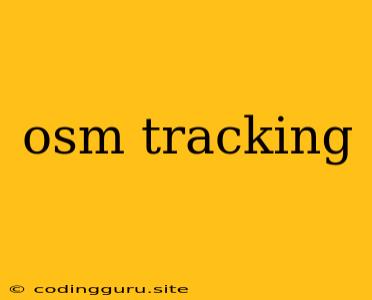Understanding and Utilizing OSM Tracking: A Comprehensive Guide
OpenStreetMap (OSM) has revolutionized the way we perceive and interact with the world around us. This collaborative mapping project provides a rich and detailed dataset, allowing us to visualize and analyze various geographical features. While OSM is known for its mapping capabilities, it also offers a powerful tool for tracking objects and movements - OSM tracking.
But what exactly is OSM tracking and how can it be utilized?
OSM tracking leverages the detailed information present in OpenStreetMap to track the movement of entities in real-time or retrospectively. This can include anything from vehicles and pedestrians to wildlife and even the flow of goods.
Here's a breakdown of how it works:
-
Data Collection: OSM tracking begins with collecting data points from various sources like GPS devices, sensor networks, or even mobile phones. These data points contain information about the location, timestamp, and potentially other attributes of the tracked entity.
-
Integration with OSM: The collected data is then integrated with the OSM database, which provides crucial context for the tracking information. This involves matching the data points with existing roads, paths, and other geographical features.
-
Visualization and Analysis: The integrated data can be visualized using mapping tools and platforms. This allows for real-time monitoring, analysis of movement patterns, and even the identification of potential bottlenecks or areas of congestion.
What are the potential applications of OSM tracking?
OSM tracking has a wide range of applications across various domains:
- Transportation: Real-time tracking of buses, trains, and taxis for improved public transport efficiency and information systems.
- Logistics: Monitoring the movement of goods, vehicles, and deliveries for optimized supply chain management.
- Environmental Monitoring: Tracking wildlife movements for conservation efforts, or studying the impact of environmental changes.
- Emergency Response: Monitoring the location and movement of first responders, enabling faster response times during disasters.
- Urban Planning: Analyzing traffic flow and pedestrian patterns for urban planning and infrastructure development.
- Personal Navigation: Enhanced navigation systems that can provide real-time information about traffic conditions, alternate routes, and even pedestrian flow.
How can you implement OSM tracking in your projects?
There are several tools and platforms available for implementing OSM tracking depending on your specific needs. Here are some popular options:
- OpenStreetMap API: The OSM API allows you to access the data directly, enabling you to programmatically retrieve, analyze, and integrate it with your own systems.
- Mapbox: This platform provides powerful mapping capabilities, including real-time location tracking and visualization tools.
- Leaflet: A lightweight and customizable Javascript library that makes it easy to integrate OSM data with web applications.
- OSM Tracking Servers: Specialized servers designed for handling large amounts of tracking data, with features for storage, analysis, and visualization.
Tips for successful OSM tracking:
- Data Quality: The accuracy and reliability of OSM tracking depend heavily on the quality of the collected data. Ensure that your data sources are reliable and consistent.
- Privacy Considerations: When dealing with sensitive information about individuals or organizations, it is crucial to adhere to privacy regulations and ensure that the data is handled responsibly.
- Data Integration: Integrate your data with OSM to gain the most value from the tracking system. Match your data points with roads, points of interest, and other relevant geographical features.
- Visualization and Reporting: Use appropriate tools and techniques to effectively visualize and analyze the tracking data. This will allow you to extract meaningful insights and make informed decisions.
Conclusion:
OSM tracking offers a powerful and versatile tool for understanding and analyzing movements in the real world. By combining the rich data available in OpenStreetMap with tracking information, it enables a wide range of applications across different domains. As the world becomes increasingly interconnected, OSM tracking will play a crucial role in optimizing operations, improving decision-making, and making the world a more efficient and informed place.
